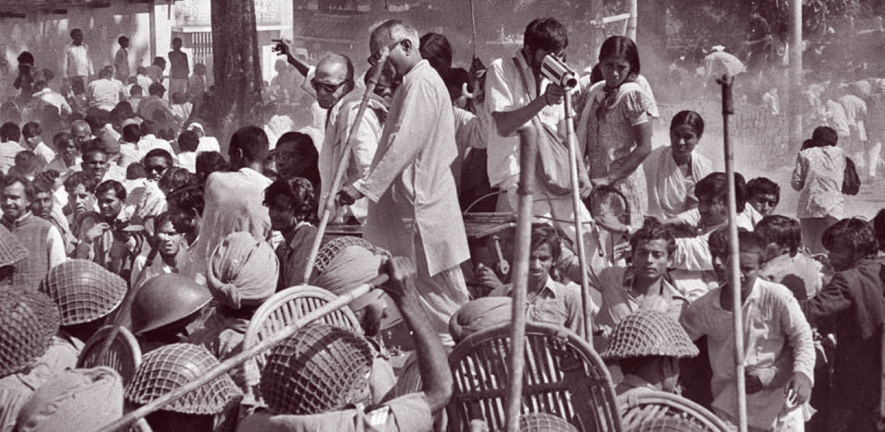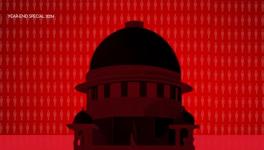Perhaps the legal community would care to demonstrate how they make the fine distinction between an Emergency regime that subverts the Constitution and suspends fundamental rights, and other regimes that do likewise in a society that is bereft of due process of law and is yet considered an electoral democracy, however tawdry.
——-
Writing in 2013, Justice Rajinder Sachar, former Chief Justice of the Delhi High Court asked the question as to whether the Emergency would have collapsed if the Supreme Court had decided the ADM Jabalpur case of 1976 differently. The court had failed to show spine and follow well-established law that in cases of habeas corpus, every imprisonment is prima facie unlawful and that it is for a person directing imprisonment to justify the act.
The Union Government held that Article 21 was the sole repository of liberty and that as the right to move for enforcement of that right had been suspended by the Presidential Order of June 27, 1975, such petitions were liable to be dismissed in limine. This objection having been overruled by nine High Courts, the appeal was heard by a five-judge constitution bench at the Supreme Court.
Also read: Why ADM Jabalpur vs. Shivkant Shukla is criticized for wrong reasons: A case for constitutionalism
“Only one of them Khanna J showed rare courage in turning this totalitarian claim. Two of them i.e. Chandrachud J and Bhagwati J (who it was generally assumed would side with the liberties of citizens) now ever wilted and joined Ray CJ and Beg J (who in any case no one expected to go against the Govt.) in dismissing the habeas corpus petitions…”
“Had the Supreme Court taken the same view as the nine high courts, the Emergency would have collapsed immediately, because no court could possibly have upheld the detention of stalwarts and patriots like Jayaprakash Narayan Ji, Morarji Desai, Raj Narain, George Fernandes, Madhu Limaye and thousands of others on the ground that they were a danger to the security of the country. The inevitable result would have been the immediate release of these leaders leading to an overwhelming opposition movement which would have swept away the Indira Gandhi government by mid 1976.”
In any other democratic country, the honourable judges would have resigned in contrition or would have been asked to resign politely after the Janata government came into power. Three of them went on to become Chief Justices of the Supreme Court of India.
The Supreme Court had failed to show spine and follow well-established law that in cases of habeas corpus, every imprisonment is prima facie unlawful and that it is for a person directing imprisonment to justify the act.
No senior officials of the Union Law or Home Ministries were called to account by the inept successor Janata Party government.
Contrast this with what the allies did after the Second World War. They prosecuted 16 German jurists and lawyers. Nine had been officials of the Reich Ministry of Justice; others were prosecutors and judges of the Special Courts, and People’s Courts of Nazi Germany.
Long-term fallout
The political masters, the denizens of the deep State and the pliant bureaucracy have no speed breakers. High court judges of known independence are not elevated to the Supreme Court: Justice Akil Kureshi being but one. The frequent usage of transfer of high court judges not on the same page as the State is yet another artifice from the Emergency.
Also read: Abolish the power to transfer High Court Judges to safeguard judicial independence
The lack of representation of judges from Dalit, tribal and minority communities in courts at all levels, at least relatively commensurate to their share of the population. The failure of courts to deal expeditiously with cases involving individual liberty from the now union territories of Jammu and Kashmir, and Delhi, as well as Uttar Pradesh and Maharashtra, to name a few. Bail being denied on specious grounds to dissenters, and no compensation being paid to those acquitted after long trials and incarcerations.
Other concerns were succinctly summarized in this publication by Parliamentarian and journalist John Brittas. “Various judgements of courts are closely scrutinised by the general public and if they have concerns and apprehensions that should not be ignored. Referring the Sabarimala verdict to a larger Bench, the Ayodhya verdict, the decision on Rafale, the divesting of powers of CBI Director Alok Verma, silence over the abrogation of Article 370 and conversion of Jammu and Kashmir State into two union territories and the long-pending case on Electoral Bonds etc have come up for numerous interpretations in the legal circles itself.”
Challenges of policing
The principal perpetrators of the massacre at Turkman Gate got away. Jagmohan, then Sanjay Gandhi’s bulldozer man, became Lieutenant Governor, Governor and a Union Minister under the subsequent United Front and National Democratic Alliance governments.
Navin Chawla, who served as the secretary to Delhi’s Lieutenant governor and then as Sanjay Gandhi’s fawning errand boy, was indicted by the Justice J.C. Shah Commission of Inquiry. “He is unfit to hold any public office which demands an attitude of fair play and consideration for others.” He had a long career in the bureaucracy and retired as the Chief Election Commissioner of India.
The police personnel who tortured and killed P. Rajan, the engineering student in Kerala, were protected by the K. Karunakaran-led Indian National Congress government in the state. Those who tortured socialist political leader Lawrence Fernandes, and actress, producer and social activist Snehalata Reddy in Karnataka were protected by the D. Devaraj Urs-led Congress government in the state. The Communist Party of India (Marxist)-led Jyoti Basu government protected the notorious Runu Guha Neogy, while Charan Singh, the Union Home Minister in the Janata party government in 1978, pinned the President’s Gold Medal for the arrest and torture of Jasbir Singh, Sudhir Goel and Tejinder Singh, who were socialist student leaders from Jawaharlal Nehru University and Delhi University.
Policing in India is plagued by political interference, a lack of basic training, the virtual absence of accountability, and a poor public image.
The excellent eighth report of the National Police Commission had recommended the removal of Section 197 from the Criminal Procedure Code. It is yet to be implemented. Torture is not an aberration in India. It is endemic.
Policing in India is plagued by political interference, a lack of basic training, the virtual absence of accountability, and a poor public image. Brutality has become endemic in police work.
Also read: The unlawfulness of police brutality in India
Preventive detention
The Maintenance of Internal Security Act (‘MISA’) was enacted in 1971 after the Preventive Detention Act (‘PDA’) in 1969 expired. PDA was enacted in 1950 and was independent India’s first preventive detention law. The powers granted to the government under MISA were similar to those in PDA.
During the emergency, many thousands were unreasonably detained. Those who were arrested under this law were without the option of a trial.
Under the 39th Amendment to the Constitution, MISA was included in the Ninth Schedule of the Constitution, which gave it complete immunity from any legal challenge or judicial scrutiny, even if it was found to be violating the fundamental rights that had been guaranteed under the Constitution or its Basic Structure.
Following the Lok Sabha election in 1977 which resulted in the Janata Party emerging as winner and forming the government, that act was finally repealed. MISA was subsequently removed from the Ninth Schedule by the 44th Constitutional Amendment Act of 1978.
No sooner did the citizen feel a sense of relief that the Deep State had the then Home Minister, Charan Singh, talk of the need for a new law allowing for preventive detention. Fortunately, the veteran socialist parliamentarian, essayist and activist Madhu Limaye opposed it tooth and nail, and the proposal was put into hibernation.
In 1978, the government adopted the 44th amendment to the Constitution, which included, amongst other provisions, significant limitations on the Constitutional authorisation of preventive detention. Although most of the 44th Amendment was brought into force with effect from June 20, 1979 over 30 years later, the preventive detention components were never given effect despite the fact that the entire Amendment was passed by both houses of Parliament and signed by the President.
After the excesses of the Emergency dramatically highlighted the ways in which the government could use preventive detention and other extraordinary executive powers to quash political dissent and the legitimate exercise of constitutional rights, the Janata government came to power with promises to curb such executive abuses. In 1978, the government adopted the 44th amendment to the Constitution, which included, amongst other provisions, significant limitations on the Constitutional authorisation of preventive detention. Although most of the 44th Amendment was brought into force with effect from June 20, 1979 over 30 years later, the preventive detention components were never given effect despite the fact that the entire Amendment was passed by both houses of Parliament and signed by the President.
Also read: Preventive Detention Laws in India: A tool for executive tyranny?
Despite disagreement over the necessity of preventive detention, there was agreement that if preventive detention was necessary, then, at a minimum, safeguards must be strengthened to prevent misuse. Still, some critics believed that no amount of safeguards could stop the executive from abusing preventive detention so long as the practice was authorised, and strongly criticised the limited revisions proposed in the Amendment
Despite the vehemence with which many Parliamentarians argued against preventive detention in the wake of the Emergency, the general consensus about the need for additional safeguards, and the ultimate passage of the Amendment by both houses of Parliament and its signing by the President, neither the Janata government, which sponsored the Amendment, nor subsequent governments have brought its Section 3 into force. Subsequently, preventive detention provisions have continued to be rampantly abused.
The failure to give effect to the amendment was challenged in A. K. Roy versus Union of India & Anr. (1981). In this case, the Supreme Court said that the delay was unexplained and unreasonable. The court also noted that there appeared to be no reason why the 44th Amendment could not have been enacted, especially as 43 of its 44 sections had been brought into force with the exception of section 3. The majority observed that no reasons were given for the omission and that they could not find any acceptable reason.
While the Supreme Court disagreed with successive governments’ failure to enact the 44th Amendment, it held that the legislation provided that the duty to bring the provisions of the amendment into force was left to the discretion of the union government. The court stated that preventive detention and enacting this amendment was a matter for the legislature, not the judiciary.
Still, while the court disagreed with successive governments’ failure to enact the 44th Amendment, it held that the legislation provided that the duty to bring the provisions of the amendment into force was left to the discretion of the union government. The court stated that preventive detention and enacting this amendment was a matter for the legislature, not the judiciary, and thus did not mandate the section’s entry into force.
With the failure to bring into force section 3 of the 44th Amendment, preventive detention has continued to be abused through old and new Parliamentary and state legislation. For example, despite the Janata government’s election promise to repeal MISA, once in power, the government maintained preventive detention as necessary to combat economic offences, “anti-social elements,” and threats to national security. Subsequently, various pieces of national legislation, including the National Security Act, 1980, the Terrorist and Disruptive Activities (Prevention) Act, 1985 and its successor, the Prevention of Terrorism Act, 2002, and the Unlawful Activities (Prevention) Amendment Bill, 2008 all have included long-term preventive detention provisions. Similarly, numerous state laws, such as the Jammu and Kashmir Public Safety Act, 1978, the Assam Preventive Detention Act, 1980, and the Tamil Nadu Prevention of Dangerous Activities of Bootleggers, Drug Offenders, Goondas, Immoral Traffic Offenders, Sand Offenders, Slum-Grabbers and Video Pirates Act, 1982, provide for long-term preventive detention.
Also read: The Dangers of UAPA Were Sown in Earlier Preventive Detention Laws in India
Both union and state governments have abused such legislation, with even the judiciary being unable to effectively limit such abuses as the detention of individuals without cause, the failure to follow even the minimal protections offered by Article 22 of the Constitution, the circumvention or ignoring of judicial orders of release, the re-issuing of new detention orders upon release, or the targeting of political opponents.
Perhaps the legal community would care to demonstrate how they make the fine distinction between an Emergency regime that subverts the Constitution and suspends fundamental rights, and other regimes that do likewise in a society that is bereft of due process of law and is yet considered an electoral democracy, however tawdry. The failure to deal with the Emergency excesses may still prove to be the incubus of today.

























